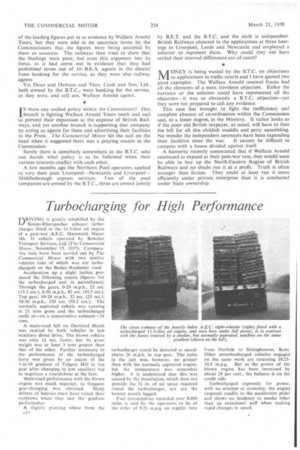Turbocharging for High Performance
Page 50

If you've noticed an error in this article please click here to report it so we can fix it.
nRIV1NG is greatly simplified by the
Simms-Eberspacher exhaust turbocharger fitted to the 11.3-litre oil engine of a post-war A.E.C. Mammoth Major Mk. II vehicle operated by Bowater Transport Services, Ltd. (The Commercial Motor, November 15, 1957). Comparative tests have been carried out by The Commercial Motor with two similar vehicles (one of which was not turbocharged) on the Bexley-Rochester road.
Acceleration up a slight incline produced the following results (figures for the turbocharged unit in parentheses): Through the gears, 0-20 m.p.h., 23 sec. (15.2 sec.); 0-30 m.p.h., 82 sec. (45.5 sec.). Top gear, 10-20 m.p.h., 32 see. (25 sec.); 10-30 m.p.h., 150 sec. (50.2 sec.). The normally aspirated vehicle was running at 21 tons gross and the turbocharged outfit at—on a conservative estimate-24 EOM.
A main-road hill on Dartford Heath was tackled by both vehicles in low auxiliary direct drive. The blown vehicle was only 11 sec. faster, but its gross weight was at least 3 tons greater than that of the other. Further testimony to the performance of the turbocharged lorry was given by an ascent of the I-in-16 gradient of Tolgate Hill in top gear after changing to low auxiliary top to negotiate a roundabout at the foot.
Main-road performance with the blown engine was much superior, as frequent gear-changing was obviated. Many drivers of heavies must have raised their eyebrows when they saw the gradient performance.
A slightly piercing whine from the c1.4
turbocharger could be detected at speeds above 26 m.p.h. in top gear. The noise in the cab was, however, no greater than with the normally aspirated engine, but the temperature was somewhat higher. It is understood that this was caused by the installation, which does not provide the 31in. of air space required round the turbocharger, nor are the bonnet panels lagged.
Fuel consumption recorded over 8,000 miles is said by the operators to be of the order of 9.21 m.p.g. on regular runs from Norfolk to Sittingbourne, Kent. Other unturbocharged vehicles engaged on the same work are returning 1025 10.5 m.p.g. But as the power of the blown engine has been increased by about 29 per cent., the balance is on the credit side.
Turbocharged expressly for power, with no attempt at economy, the engine responds readily to the accelerator pedal and shows no tendency to smoke other than an occasional puff when making rapid changes in speed.








































































































